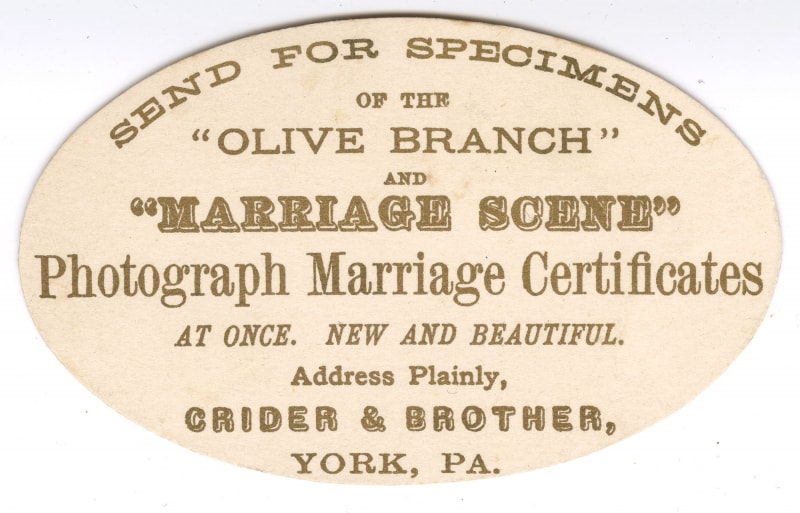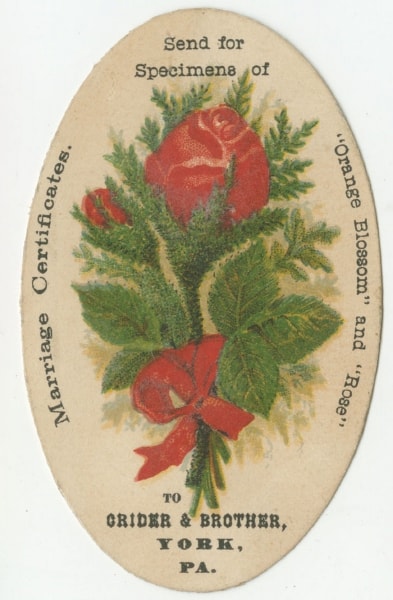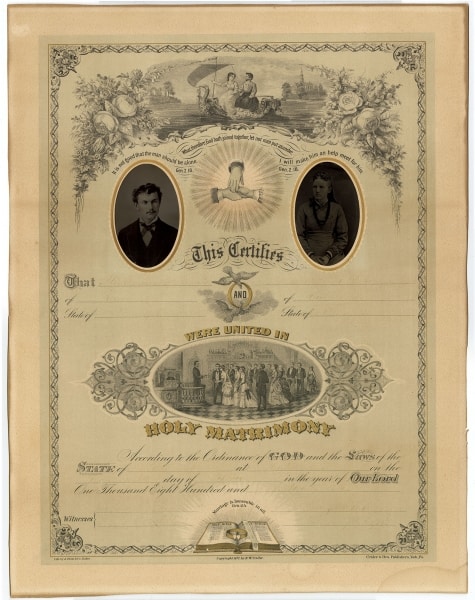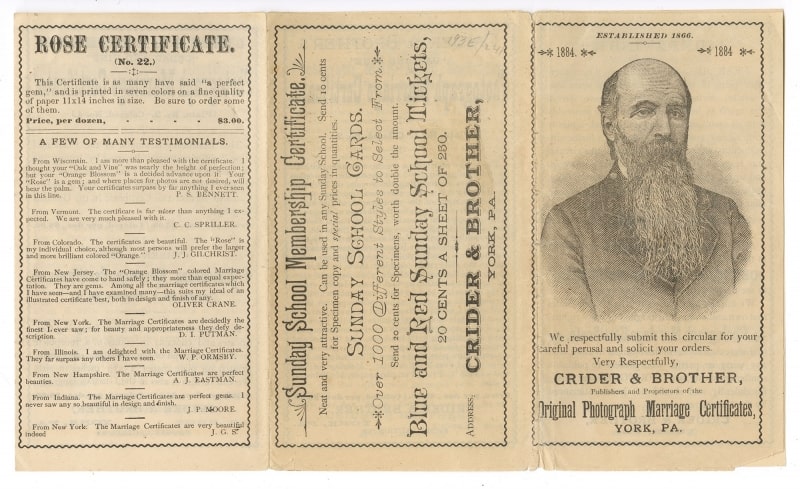Curator’s Favorite: Wedding Industry, Victorian-Style
Send for Specimens of the “Olive Branch” and “Marriage Scene.” … Address Plainly Crider & Brother, York, Pa. (York, Pa., ca. 1880). Lithograph with gilt.
Send for Specimens of “Orange Blossom” and “Rose” to Crider & Brother, York, Pa. Marriage Certificates (York, Pa., ca. 1882). Chromolithograph. Gift of David Doret.
Crider & Brother marriage scene-style photograph marriage certificate (York, Pa.: Crider & Brother, 1877). Completed in manuscript in 1879. Color lithograph.
For many, the month of June means the start of the wedding season. More recently, the wedding season has also become synonymous with the wedding industry. However, the commercialization of weddings is not new. This recently acquired circa 1880 advertisement for “marriage scene” certificates issued by York, PA publisher Crider & Brother shows that certain Victorian businesses had already started to capitalize on memorializing the big day. It complements a similar Crider advertisement we hold for the publisher’s “orange blossom” and “rose” photograph marriage certificates. Given their oval shape, the cards were possibly used as inserts in spaces for photographs on Crider certificate specimens.
Crider & Brother, Publishers and Proprietors of the Original Photograph Marriage Certificates, York, Pa. (York, Pa., 1884). Gift of David Doret.
Established in 1866 as Kephart, Crider & Co., the firm’s partners included David Crider (1842-1914), a Civil-War legend from his re-enlistment in the army after being erroneously declared dead at Antietam. He often copyrighted many of the company’s nationally and internationally-sold print designs that also illustrated birth, baptismal, and confirmation certificates. Although information about Crider from public records is more easily gathered than that of Crider & Brother, the prints issued by the firm, as well as their 1884 circular in our holdings, still provide historical anecdotes.
The Library Company holds a number of Crider photograph marriage certificates, including the “marriage scene” style advertised in our new acquisition. Although the ink-recorded names of the married couple have faded on our copy, their portraits — economical tintype photographs on metal — have not. Depicted in their Sunday best, the new husband and wife’s likenesses complete the lithographic certificate illustrated with a “beautiful picture representing the voyage of life” and a “pretty engraving representing a marriage scene in a church.” Unlike the couple married in 1879 who owned this print, the bride and groom in the scene are portrayed as a Victorian ideal. The bride wears a white wedding dress. The groom wears a tuxedo with tails. The attire portrayed was likely beyond the means of the couple whose tintypes served as their re-purposed wedding photographs. The certificate priced at about fifty cents would have represented the extravagant expenditure for their nuptials.
Crider & Brother orange blossom-style photograph marriage certificate (York, Pa.: Crider & Brother, 1882). Completed in manuscript in 1885. Chromolithograph. Gift of David Doret.
Printed in color and selling for a dollar wholesale, the “orange blossom” certificate was the preference of the about twenty-five-year-old Thomas Radle (b. 1861) and teen-aged Mary Dasher (b. ca. 1867-1894). Containing their portrait photographs, the certificate documents that D.W. Proffitt (1841-1913) of the United Memorial Brethren Church married the couple in September 1885 in Pittsburgh. Thomas appears in a suit, derby hat, and with a cigarette in his mouth. Mary wears a long-sleeve, dark-colored dress with a bustle. Although used in a marriage certificate, and especially given Radle’s pose, the photographs, as with the previous couple, were probably ones the couple already possessed. They had not acquired them for the occasion, although possibly for the certificate. A genealogical record, the certificate’s content also provides a trail of evidence for more concrete information about the couple. Mary, likely a domestic servant before her marriage, passed away in 1894. As traced in census and marriage documents, Thomas, a railroad laborer, then farmer, later marries her sister Clara Dasher (1872-1960). He is listed as widowed and she as his housekeeper in the 1900 census. By the summer of 1900, a Pennsylvania marriage license has been issued to the couple. And in the 1910 census, Clara is described as Thomas’s wife.
Weddings are history-making events for the couple married. In the modern era, they can also be history making in terms of cost. The Crider & Brother prints and ephemera are humble, yet symbolic artifacts of wedding commercialization. They are captivating mementoes of wedding practices of the past, while also perspicacious harbingers of wedding practices of today.
Erika Piola
Associate Curator, Prints and Photographs and Director, Visual Culture Program
Sources:
Ancestry.com accessed April 16 and 17, 2018.
Crider & Brother, Publishers and Proprietors of the Original Photograph Marriage Certificates, York, Pa. (York, Pa., 1884).
George Reeser Prowell, History of York County, Pennsylvania (Chicago: J. H. Beers, 1907), vol. 2, 497-498.







